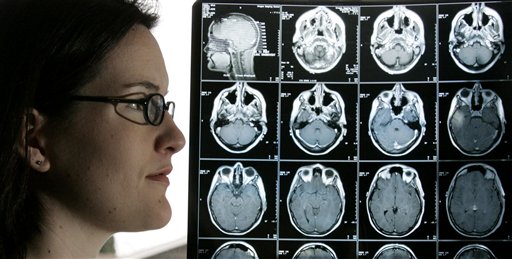Duke University Discover Unlikely Possible Cure for Brain Cancer: Polio

Kyla Nagel stands next to her brain scan at her home Friday, Jan. 28, 2005, in Springfield, Ore. Nagel was diagnosed with an aggressive brain cancer three years. After undergoing conventional treatment, including chemotherapy, and having the tumor return, she enrolled in a research regimen using an experimental drug and now her brain scans show no sign of cancer. A recent study shows that brain cancer in adults is a dreaded diagnosis with few established treatment guidelines _ resulting in wide variations in treatment that risk making things even worse for some patients. (AP Photo/Rick Bowmer)
August 15, 2016
By: Julia Michaelson
Doctors are using a debilitating disease, nearly wiped out globally, to treat one of the most dangerous types of brain tumor.

In 2012, 58 year-old Nancy Justice found out she had a brain tumor. She had been diagnosed with Glioblastoma. Justice was told she had seven months to live. According to CBS News, doctors said they can only give Justice enough radiation, surgery, and chemotherapy to slow the tumor growth.
Due to a recent finding, Justice has been given a second shot.
Every year out of all the cancers diagnosed, 2% of those people get the news of having Glioblastoma. These are tumors make up a large portion of the increase in cancer rates. The tumors contain a mixture of cells which are nourished by a large amount of blood supply.
Duke University is currently running a clinical trial to help cure Glioblastoma. Doctors at Duke found that if the Polio Virus is injected into the tumor it kills tumor cells.
According to the Preston Robert Brain Tumor Center, the Polio Virus triggers a human’s immune system to fight the virus. While attacking the Polio Virus, it also can attack the tumor.
Justice had the Polio Virus injected into her. After fighting for two and a half years with her tumor, the tumor was shrinking. Justice has been doing much better.
One day, she came in for an MRI and doctors noticed a huge issue. There was a massive amount of inflammation around her tumor due to dead tumor cells. The cells were not able to go away, and the inflammation engulfed her brain. Justice died April 6, 2016.
Since then, Duke has been making improvements to their treatments. In some cases though, people are cured. For example, Stephanie Lipscomb was a healthy nursing student, and she started to have headaches.

The doctors were concerned and told her to get an MRI. They found she had a tumor the size of a tennis ball. Lipscomb was only 20 at the time.
In 2011, she had 98% of the tumor removed.
Thinking everything was going to be fine, Lipscomb heard news in 2012 that her cancer was back. Dr. Annick Desjardins suggested the Polio Virus treatment. According to CBS News, Lipscomb said, “Let’s do it, come on, let’s go.”
Lipscomb’s tumor shrank. In 21 months, there was no sign of the tumor. She was and still is to this day cancer free.
On Duke’s cancer research page, there is a tab titled Duke there is Hope. Here people have listed Glioblastoma and other brain tumors have affected their life. They also list how they got through it.
On the Duke cancer research website, patient Glenda Hurley posted, “Preston Robert Tisch Brain Tumor Center gives me HOPE and with my faith I will be running the race next year with my team.”




